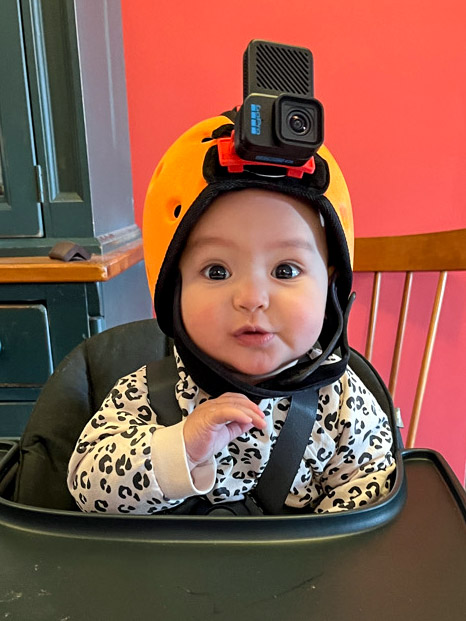
[ad_1]
For this experiment, the researchers trusted 61 hours of video from a helmet digicam worn via a kid who lives close to Adelaide, Australia. That kid, Sam, wore the digicam on and off for one and a part years, from the time he was once six months previous till a little bit after his 2nd birthday. The digicam captured the issues Sam checked out and paid consideration to all through about 1% of his waking hours. It recorded Sam’s two cats, his folks, his crib and toys, his area, his foods, and a lot more. “This information set was once completely distinctive,” Lake says. “It’s the most efficient window we’ve ever had into what a unmarried kid has get admission to to.”
To coach the fashion, Lake and his colleagues used 600,000 video frames paired with the words that had been spoken via Sam’s folks or people within the room when the picture was once captured—37,500 “utterances” in all. Every so often the phrases and gadgets matched. Every so often they didn’t. As an example, in a single nonetheless, Sam appears to be like at a form sorter and a guardian says, “You just like the string.” In every other, an grownup hand covers some blocks and a guardian says, “You need the blocks too.”
COURTESY OF SAM’S DAD
The staff gave the fashion two cues. When gadgets and phrases happen in combination, that’s an indication that they could be connected. But if an object and a phrase don’t happen in combination, that’s an indication they most likely aren’t a fit. “So we’ve this kind of pulling in combination and pushing aside that happens inside the fashion,” says Wai Prepared Vong, a computational cognitive scientist at New York College and an creator of the find out about. “Then the hope is that there are sufficient circumstances within the knowledge the place when the guardian is announcing the phrase ‘ball,’ the child is seeing a ball,” he says.
Matching phrases to the gadgets they constitute might look like a easy job, nevertheless it’s now not. To come up with a way of the scope of the issue, believe the lounge of a circle of relatives with small children. It has the entire standard front room furnishings, but in addition child litter. The ground is affected by toys. Crayons are scattered around the espresso desk. There’s a snack cup at the windowsill and laundry on a chair. If a baby hears the phrase “ball,” it would seek advice from a ball. However it would additionally seek advice from another toy, or the sofa, or a couple of pants, or the form of an object, or its colour, or the time of day. “There’s a limiteless collection of imaginable meanings for any phrase,” Lake says.
The issue is so intractable that some developmental psychologists have argued that youngsters will have to be born with an innate working out of the way language works with the intention to be told it so briefly. However the find out about means that some portions of language are learnable from a truly small set of reviews even with out that innate talent, says Jess Sullivan, a developmental psychologist at Skidmore College, who was once a part of the staff that gathered Sam’s helmet digicam knowledge however was once now not concerned within the new find out about. “That, for me, truly does shake up my worldview.”
However Sullivan issues out that having the ability to fit phrases to the gadgets they constitute, despite the fact that a difficult studying downside, is simply a part of what makes up language. There also are regulations that govern how phrases get strung in combination. Your canine would possibly know the phrases “ball” or “stroll,” however that doesn’t imply he can perceive English. And it may well be that no matter innate capability for language young children possess is going past vocabulary. It will affect how they transfer in the course of the international, or what they be aware of, or how they reply to language. “I don’t suppose the find out about would have labored if young children hadn’t created the information set that the neural web was once studying from,” she says.

BRENDEN LAKE
Your next step for Lake and his colleagues is to take a look at to determine what they wish to make the fashion’s studying extra intently reflect early language studying in youngsters. “There’s extra paintings to be carried out to take a look at to get a fashion with totally two-year-old-like talents,” he says. That would possibly imply offering extra knowledge. Lake’s kid, who’s now 18 months previous, is a part of the following cohort of youngsters who’re offering that knowledge. She wears a helmet digicam for a couple of hours per week. Or in all probability the fashion wishes to be aware of the fogeys’ gaze, or to have some sense of the solidity of gadgets—one thing youngsters intuitively clutch. Growing fashions that may be told extra like youngsters will lend a hand the researchers higher perceive human studying and building.
AI fashions that may select up one of the techniques by which people be told language could be way more environment friendly at studying; they may act extra like people and no more like “a lumbering statistical engine for trend matching,” because the linguist Noam Chomsky and his colleagues as soon as described massive language fashions like ChatGPT. “AI techniques are nonetheless brittle and shortage not unusual sense,” says Howard Shrobe, who manages this system at the USA govt’s Protection Complex Analysis Initiatives Company that helped fund Lake’s staff. However AI that might be told like a kid would possibly be able to working out that means, responding to new eventualities, and studying from new reviews. The purpose is to deliver AI one step nearer to human intelligence.
[ad_2]